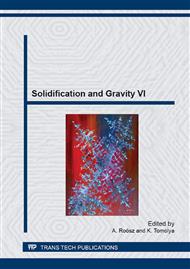[1]
Davis Jr J.R. et al., Impurities in silicon solar cells. IEEE Transactions on Electron Devices, 1980. ED-27(4): pp.677-687.
Google Scholar
[2]
Coletti G., Sensitivity of state-of-the-art and high efficiency crystalline silicon solar cells to metal impurities. Progress in Photovoltaics: Research and Applications, 2012: p. n/a-n/a.
DOI: 10.1002/pip.2195
Google Scholar
[3]
Buonassisi T. et al., Metal precipitation at grain boundaries in silicon: Dependence on grain boundary character and dislocation decoration. Applied Physics Letters, 2006. 89(4): pp.042102-3.
DOI: 10.1063/1.2234570
Google Scholar
[4]
Chen J. et al., Electron-beam-induced current study of grain boundaries in multicrystalline silicon. Journal of Applied Physics, 2004. 96(10): pp.5490-5495.
DOI: 10.1063/1.1797548
Google Scholar
[5]
Chen J. et al., Recombination activity of σ3 boundaries in boron-doped multicrystalline silicon: Influence of iron contamination. Journal of Applied Physics, 2005. 97(3): pp.033701-5.
DOI: 10.1063/1.1836009
Google Scholar
[6]
Martinuzzi S. et al., Segregation phenomena in large-size cast multicrystalline Si ingots. Solar Energy Materials and Solar Cells, 2007. 91(13): pp.1172-1175.
DOI: 10.1016/j.solmat.2007.03.026
Google Scholar
[7]
Maurice J.L. et al., Fast diffusers Cu and Ni as the origin of electrical activity in a silicon grain boundary. Applied Physics Letters, 1989. 55(3): pp.241-243.
DOI: 10.1063/1.101919
Google Scholar
[8]
Chen J. et al., Electron-beam-induced current study of small-angle grain boundaries in multicrystalline silicon. Scripta Materialia, 2005. 52(12): pp.1211-1215.
DOI: 10.1016/j.scriptamat.2005.03.010
Google Scholar
[9]
Kazmerski L.L. et al., Evidence for the segregation of impurities to grain boundaries in multigrained silicon using Auger electron spectroscopy and secondary ion mass spectroscopy. Applied Physics Letters, 1980. 36(4): pp.323-325.
DOI: 10.1063/1.91479
Google Scholar
[10]
Pizzini S. et al., From electronic grade to solar grade silicon: chances and challenges in photovoltaics. physica status solidi (a), 2005. 202(15): pp.2928-2942.
DOI: 10.1002/pssa.200521104
Google Scholar
[11]
Lu J. et al., Effects of grain boundary on impurity gettering and oxygen precipitation in polycrystalline sheet silicon. Journal of Applied Physics, 2003. 94(1): pp.140-144.
DOI: 10.1063/1.1578699
Google Scholar
[12]
Sachdeva R. et al., Recombination activity of copper in silicon. Applied Physics Letters, 2001. 79(18): pp.2937-2939.
DOI: 10.1063/1.1415350
Google Scholar
[13]
Buonassisi T. et al., Analysis of copper-rich precipitates in silicon: Chemical state, gettering, and impact on multicrystalline silicon solar cell material. Journal of Applied Physics, 2005. 97(6): pp.063503-9.
DOI: 10.1063/1.1827913
Google Scholar
[14]
Savin H. et al., Role of copper in light induced minority-carrier lifetime degradation of silicon. Applied Physics Letters, 2009. 95(15): p.152111.
DOI: 10.1063/1.3250161
Google Scholar
[15]
Tang K. et al., Critical assessment of the impurity diffusivities in solid and liquid silicon. JOM Journal of the Minerals, Metals and Materials Society, 2009. 61(11): pp.49-55.
DOI: 10.1007/s11837-009-0167-7
Google Scholar
[16]
Information on https: /www. vasp. at.
Google Scholar
[17]
Kresse G. et al., Efficient iterative schemes for ab initio total-energy calculations using a plane-wave basis set. Physical Review B, 1996. 54(16): pp.11169-11186.
DOI: 10.1103/physrevb.54.11169
Google Scholar
[18]
Autruffe A. et al., Impact of growth rate on impurities segregation at grain boundaries in silicon during Bridgman growth. Journal of Crystal Growth, 2013. 372(0): pp.180-188.
DOI: 10.1016/j.jcrysgro.2013.03.037
Google Scholar
[19]
Trempa M. et al., Mono-crystalline growth in directional solidification of silicon with different orientation and splitting of seed crystals. Journal of Crystal Growth, 2012. 351(1): pp.131-140.
DOI: 10.1016/j.jcrysgro.2012.04.035
Google Scholar
[20]
Perdew J.P. et al., Generalized Gradient Approximation Made Simple. Physical Review Letters, 1996. 77(18): pp.3865-3868.
DOI: 10.1103/physrevlett.77.3865
Google Scholar
[21]
Trumbore F.A., Solid solubilities of impurity element in germanium and silicon. Bell Labs Tech. J., 1960. 39: pp.205-33.
DOI: 10.1002/j.1538-7305.1960.tb03928.x
Google Scholar


